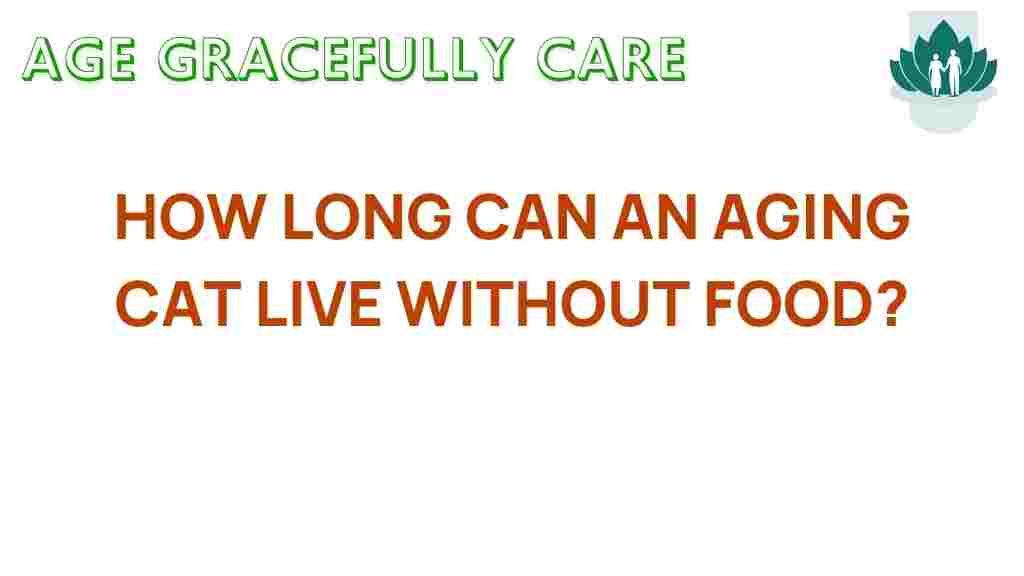The Startling Truth: How Long Can an Aging Cat Survive Without Food?
As our beloved feline companions age, their health needs become a primary concern for pet owners. One of the most pressing issues that arise is the question of how long an aging cat can survive without food. Understanding the implications of hunger in cats and ensuring proper cat nutrition is crucial for maintaining feline health. In this article, we will explore the survival without food for aging cats, the nutritional needs that must be met, and the veterinary advice you should follow to keep your furry friend healthy and happy.
Understanding the Basics of Feline Nutrition
Before we delve into the survival limits of aging cats without food, it is essential to understand their nutritional needs. Cats are obligate carnivores, which means they require a diet primarily composed of meat to thrive. Here are some key points regarding cat nutrition:
- Protein Needs: Aging cats require a high-protein diet to maintain muscle mass and overall health.
- Fat Requirements: Healthy fats are essential for energy and nutrient absorption.
- Water Intake: Hydration is critical; cats often do not drink enough water, so wet food can help.
- Vitamins and Minerals: Essential nutrients must be present in their diet to support various bodily functions.
How Long Can an Aging Cat Survive Without Food?
The question of survival without food is complex and varies from one cat to another. Generally, an aging cat can survive for about 1 to 2 weeks without food, depending on several factors, including:
- Body Condition: A cat’s overall health and fat reserves play a significant role in survival.
- Hydration: Cats can survive longer without food if they have access to water.
- Underlying Health Issues: Pre-existing conditions can affect their ability to endure fasting.
During this period, the cat will experience a range of negative effects due to lack of nutrition, including weight loss, muscle wasting, and a weakened immune system. It is critical to note that even a short period without food can lead to serious health issues, especially in aging cats.
Signs of Hunger in Cats
Recognizing the signs of hunger in cats can help pet owners take immediate action. Here are some common indicators:
- Increased Vocalization: Cats may meow more frequently when they are hungry.
- Begging Behavior: Cats may follow you around or paw at their food bowls.
- Food Seeking: They may search for food in unusual places.
- Changes in Activity Level: A hungry cat may become restless or overly active.
Step-by-Step Process to Ensure Your Aging Cat’s Nutritional Needs Are Met
To ensure your aging cat receives the nutrition they need, follow this step-by-step process:
1. Consult Your Veterinarian
Before making any changes to your cat’s diet, it’s essential to seek veterinary advice. Your vet can assess your cat’s health, recommend appropriate dietary adjustments, and rule out any underlying health issues that may contribute to a loss of appetite.
2. Choose High-Quality Cat Food
Select a nutritionally balanced cat food specifically formulated for aging cats. Look for products that contain:
- High-quality protein sources.
- Healthy fats, particularly omega-3 and omega-6 fatty acids.
- Adequate vitamins and minerals to support immune function and overall health.
3. Monitor Eating Habits
Keep a close eye on your cat’s eating habits. If your aging cat refuses to eat or shows a significant decrease in appetite, consult your veterinarian immediately.
4. Provide Fresh Water
Ensure your cat has access to fresh water at all times. Dehydration can exacerbate the effects of hunger and lead to serious health complications.
5. Consider Wet Food
Wet cat food can be an excellent option for aging cats, as it often contains higher moisture content and may be more palatable. This can help in keeping your cat hydrated and encourage them to eat.
Troubleshooting Tips for Feeding an Aging Cat
If your aging cat is experiencing issues with eating, consider the following troubleshooting tips:
- Adjust Feeding Times: Offer food at different times of the day to see if your cat prefers a particular schedule.
- Warm Up Food: Slightly warming wet food can enhance its aroma and make it more appealing.
- Change Food Types: Sometimes, a new flavor or brand can reignite your cat’s interest in food.
- Check Dental Health: Dental issues can lead to pain when eating; schedule a veterinary dental check-up if necessary.
- Reduce Stress: Create a calm feeding environment, free from loud noises and other pets.
The Importance of Regular Veterinary Check-Ups
Regular veterinary visits are crucial for monitoring the health of your aging cat. During these check-ups, your vet can:
- Assess your cat’s weight and body condition.
- Evaluate dietary needs and make recommendations.
- Check for signs of underlying health issues that can affect appetite and nutrition.
As a cat owner, keeping up with these check-ups is essential for ensuring your feline friend leads a long, healthy life.
Conclusion
Understanding how long an aging cat can survive without food is vital for every cat owner. While they may endure a week or two without nutrition, the consequences can be dire. Ensuring that your aging cat receives proper nutrition is essential for their health and well-being. Always consult with your veterinarian to tailor your cat’s diet to their specific needs and monitor their health closely. By providing a balanced diet, adequate hydration, and regular veterinary care, you can help your aging cat thrive and enjoy their golden years.
For more information on feline health and nutrition, visit A Paw of Compassion. Additionally, if you’re looking for tips on pet care, check out our pet care resources.
This article is in the category Health and created by AgeGracefullyCare Team
